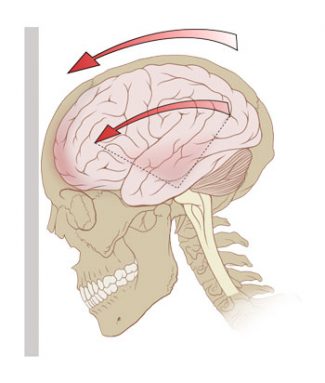Too many football hits can change the brain
Scientists discover former football player had developed serious brain damage

Repeated concussions sustained during football can cause serious damage to the brain, even in young adults.
SKYNESHER/ISTOCKPHOTO.COM
Share this:
- Share via email (Opens in new window) Email
- Click to share on Facebook (Opens in new window) Facebook
- Click to share on X (Opens in new window) X
- Click to share on Pinterest (Opens in new window) Pinterest
- Click to share on Reddit (Opens in new window) Reddit
- Share to Google Classroom (Opens in new window) Google Classroom
- Click to print (Opens in new window) Print
In the late 2015 movie, Concussion, Will Smith plays real-life doctor Bennet Omalu. In 2005, Omalu found CTE — an Alzheimer’s-like brain disease — in former football players. The disease was known to occur in people who had experienced repeated hits to the head, such as boxers. It also has been seen in hockey players, wrestlers and military veterans — usually as they enter their 40s to 70s. But a disturbing new study now reports CTE in a young college football player.
CTE is short for chronic traumatic encephalopathy (En-sef-uh-LAH-puh-thee). It is one of several diseases caused by changes to a brain protein called “tau” (which rhymes with wow). Other tau disorders include Alzheimer’s and Parkinson’s diseases.
In healthy brain cells, tau proteins support the cell. They move nutrients and other materials from one part of a cell to another. But after head trauma, tau proteins can change. They may form thread-like tangles that jam up the transport system.
What symptoms these tangles cause depends on where in the brain they show up. Alzheimer’s disease usually starts in the hippocampus. This brain region is involved with memory, so affected people suffer memory loss and confusion. In CTE, tau proteins begin to change in the prefrontal cortex. This area — located right behind the forehead — is involved with decision-making, emotion and behavior. So CTE victims are likely to become moody, aggressive and depressed. Some may attempt suicide.
Ann McKee is a pathologist at Boston University in Massachusetts. (A pathologist studies disease, usually in people who have died.) She and her team have been working to understand how CTE develops. So far, they have identified more than 170 cases of the disease in former athletes and military veterans.

In their latest report, this team describes a young man. The 25-year-old had played football for 16 years, starting at age 6. Over the years, he suffered at least 10
concussions
— brain injuries due to severe blows to the head. The first happened when he was playing football as an 8-year old.
Twelve years later, he was still playing football — and getting hurt. A major concussion during his first year of college led to headaches, blurred vision, memory loss and insomnia. Those symptoms persisted into the next season. Eventually the young man quit the game. Formerly a good student, he began failing his classes. At last, he dropped out of college without finishing his degree.
Problems continued. The young man got a job — but then lost it. Afterward, he struggled to find work. And he became abusive. Although he did not attempt suicide, he reported thinking about it. As his symptoms worsened, he underwent psychological testing. He was just 24. Those tests showed he was able to receive and register verbal information. But he struggled with memory, planning and organization.
When the young man died of a heart attack at age 25, his family agreed to let researchers examine his brain. McKee’s team looked for tau tangles. They also had a group of medical experts review the young man’s behavioral history and the results of his psychological evaluation. McKee’s group wanted to know whether CTE might be identified without having to dissect the brain.
Currently, the only way to diagnose the disease is to look at brain tissue after death, explains McKee. Scientists must see a specific pattern of tau tangles under a microscope. But McKee is part of a program looking for early markers of CTE — symptoms that could point to the disease while people are still alive.
In the new case, the medical experts all agreed the young man had suffered from depression. He also had post-concussion syndrome. This is a term used to describe weeks or months of headaches, memory loss or other problems that can follow a concussion. The group was less sure about CTE, primarily because it usually shows up when people are at least 40 years old. But they didn’t rule it out.
When the researchers later opened up the man’s brain, McKee’s team saw the unmistakable evidence of CTE. And it wasn’t just in the prefrontal cortex. Tau tangles tied up cells in 10 regions of the brain. The researchers had previously found localized areas of CTE in players as young as 17 years. But they had never before found it to be so widespread in someone as young as this man.
This also marks the first time scientists have verified CTE in someone who had undergone psychological testing, McKee notes. Such testing, she adds, may be useful one day in diagnosing CTE before death.
Her team reported its findings on January 4 in JAMA Neurology.
“Findings like this are essential in CTE research,” says Mark Herceg. He’s a concussion psychologist at Cornell University in Ithaca, N.Y. He was not involved with the study.
“It’s important to highlight that this is a case study,” he adds. By that he means, this is just one example. Researchers would need many more cases to verify their findings. “If everyone who had multiple repetitive [brain] hits developed CTE, we’d have millions of disabled or deceased people everywhere,” he says. But that isn’t happening. So researchers need to figure out what other risk factors — such as genetics, trauma or poverty — might also play a role in the disease or making someone vulnerable to it.
Power Words
(for more about Power Words, click here)
Alzheimer’s disease An incurable brain disease that can cause confusion, mood changes and problems with memory, language, behavior and problem solving. No cause or cure is known.
cell The smallest structural and functional unit of an organism. Typically too small to see with the naked eye, it consists of watery fluid surrounded by a membrane or wall. Animals are made of anywhere from thousands to trillions of cells, depending on their size.
chronic traumatic encephalopathy (CTE) A brain disease caused by repeated head injuries. It has been seen, during autopsy, in the brains of former athletes and soldiers. CTE can cause memory loss, moodiness, aggression, depression and anxiety.
concussion Temporary unconsciousness, or headache, dizziness or forgetfulness due to a severe blow to the head.
deceased An adjective that describes someone who has died.
depression A mental illness characterized by persistent sadness and apathy. Although these feelings can be triggered by events, such as the death of a loved one or the move to a new city, that isn’t typically considered an “illness” — unless the symptoms are prolonged and harm an individual’s ability to perform normal daily tasks (such as working, sleeping or interacting with others). People suffering from depression often feel they lack the energy needed to get anything done. They may have difficulty concentrating on things or showing an interest in normal events. Many times, these feelings seem to be triggered by nothing; they can appear out of nowhere.
genetic Having to do with chromosomes, DNA and the genes contained within DNA. The field of science dealing with these biological instructions is known as genetics. People who work in this field are geneticists.
hippocampus A seahorse-shaped region of the brain. It is thought to be the center of emotion, memory and the involuntary nervous system.
insomnia An inability to get to sleep and stay asleep long enough to become fully rested.
neurology A research field that studies the anatomy and function of the brain and nerves. People who work in this field are known as neurologists (if they are medical doctors) or neuroscientists if they are researchers with a PhD.
nutrient A vitamin, mineral, fat, carbohydrate or protein that a plant, animal or other organism requires as part of its food in order to survive.
Parkinson’s disease A disease of the brain and nervous system that causes tremors and affects movement, memory and mood.
pathology The study of diseases and/or conditions that can or did lead to death. People who work in this field are called pathologists. They look at what causes a disease, how symptoms develop and may examine all stages of an illness.
post-concussion syndrome Symptoms that can follow a concussion for weeks or months. These include headaches, dizziness, memory problems and trouble concentrating.
prefrontal cortex A region containing some of the brain’s gray matter. Located behind the forehead, it plays a role in making decisions and other complex mental activities, in emotions and in behaviors.
proteins Compounds made from one or more long chains of amino acids. Proteins are an essential part of all living organisms. They form the basis of living cells, muscle and tissues; they also do the work inside of cells. The hemoglobin in blood and the antibodies that attempt to fight infections are among the better-known, stand-alone proteins.Medicines frequently work by latching onto proteins.
psychology (adj. psychological) The study of the human mind, especially in relation to actions and behavior. To do this, some perform research using animals. Scientists and mental-health professionals who work in this field are known as psychologists.
tau protein A protein found in the brain that plays a role in moving materials around a cell. Changes in tau proteins can lead to tangles in this transport system. Any of several brain diseases can result, including Alzheimer’s disease and chronic traumatic encephalopathy (CTE).
tissue Any of the distinct types of material, comprised of cells, which make up animals, plants or fungi. Cells within a tissue work as a unit to perform a particular function in living organisms. Different organs of the human body, for instance, often are made from many different types of tissues. And brain tissue will be very different from bone or heart tissue.
trauma (adj. traumatic) Serious injury or damage to an individual’s body or mind.







